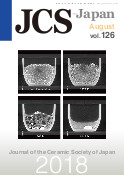Volume 126, Issue 8
Displaying 1-13 of 13 articles from this issue
- |<
- <
- 1
- >
- >|
-
2018Volume 126Issue 8 Pages H8-1
Published: 2018
Released on J-STAGE: August 01, 2018
Download PDF (236K) -
2018Volume 126Issue 8 Pages C8-1-C8-2
Published: 2018
Released on J-STAGE: August 01, 2018
Download PDF (750K)
Full paper
-
2018Volume 126Issue 8 Pages 595-601
Published: August 01, 2018
Released on J-STAGE: August 01, 2018
Download PDF (5559K)
Special Articles: The 72th CerSJ Awards for Advancements in Ceramic Science and Technology: Review
-
2018Volume 126Issue 8 Pages 602-608
Published: August 01, 2018
Released on J-STAGE: August 01, 2018
Download PDF (2631K)
Special Articles: The 70th CerSJ Awards for Advancements in Ceramic Science and Technology: Review
-
2018Volume 126Issue 8 Pages 609-613
Published: August 01, 2018
Released on J-STAGE: August 01, 2018
Download PDF (3898K)
Special Articles: The 67th CerSJ Awards for Advancements in Ceramic Science and Technology: Review
-
2018Volume 126Issue 8 Pages 614-624
Published: August 01, 2018
Released on J-STAGE: August 01, 2018
Download PDF (4570K)
Special Articles: The 72th CerSJ Awards for Advancements in Ceramic Science and Technology: Paper
-
2018Volume 126Issue 8 Pages 625-631
Published: August 01, 2018
Released on J-STAGE: August 01, 2018
Download PDF (2131K)
Full papers
-
2018Volume 126Issue 8 Pages 632-640
Published: August 01, 2018
Released on J-STAGE: August 01, 2018
Download PDF (13348K) -
2018Volume 126Issue 8 Pages 641-646
Published: August 01, 2018
Released on J-STAGE: August 01, 2018
Download PDF (7668K) -
2018Volume 126Issue 8 Pages 647-654
Published: August 01, 2018
Released on J-STAGE: August 01, 2018
Download PDF (4807K) -
2018Volume 126Issue 8 Pages 655-661
Published: August 01, 2018
Released on J-STAGE: August 01, 2018
Download PDF (2742K) -
2018Volume 126Issue 8 Pages 662-666
Published: August 01, 2018
Released on J-STAGE: August 01, 2018
Download PDF (4162K)
Announcement
-
2018Volume 126Issue 8 Pages A8-1
Published: 2018
Released on J-STAGE: August 01, 2018
Download PDF (73K)
- |<
- <
- 1
- >
- >|
